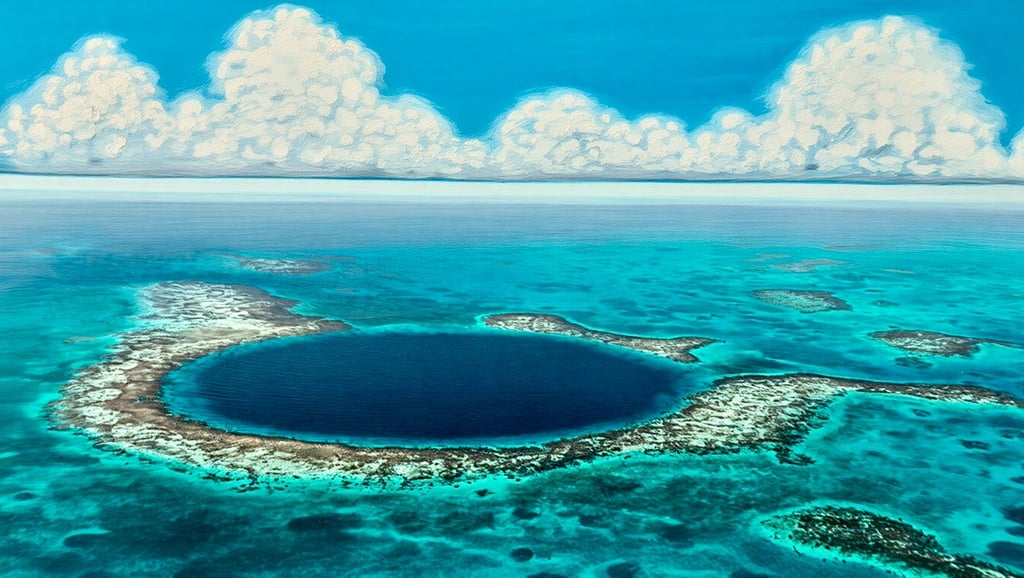The Belize Barrier Reef Reserve System: Coral Kingdom with a Sense of Humour
Uncover the Belize Barrier Reef Reserve System, a UNESCO World Heritage Site. Explore the Great Blue Hole, snorkel with sharks and rays, kayak through mangroves, and uncover the dazzling marine life of the Caribbean’s coral kingdom.
ECHOES OF ELSEWHERECARIBBEANBELIZEUNESCOTROPICALNATURAL ATTRACTIONNATURENATIONAL PARKISLANDPARADISESNORKELLING


Belize Barrier Reef, Belize
There are natural wonders that make you gasp, and then there are natural wonders that make you wonder if the planet has been secretly showing off. The Belize Barrier Reef Reserve System firmly belongs in the second camp. Stretching over 300 kilometres along the coast of Belize, this is the largest barrier reef in the Northern Hemisphere and the second largest in the world after Australia’s Great Barrier Reef. In other words, it is Australia’s slightly smaller but considerably less crowded cousin, with just as much sparkle and far fewer tour buses.
This UNESCO World Heritage Site is not just a reef, but a living carnival of coral cays, atolls, lagoons, mangroves and marine life that insist on reminding us humans that we are, at best, guest stars in the ocean’s show. It is equal parts fragile ecosystem and adventure playground, with fish that look like they have been dressed by carnival designers, turtles that glide with ancient gravitas, and a whole lot of water that seems to change its shade of blue just to keep your camera busy.
A Natural Marvel With Bite-Sized Stats
Let us indulge the numbers for a moment, because they are impressive. The Belize Barrier Reef Reserve System covers roughly 963 kilometres squared of reef, lagoons and islands, and supports over 500 species of fish, 100 species of coral, and enough invertebrates to make any marine biologist hyperventilate with joy. Charles Darwin once visited and casually remarked that it was “the most remarkable reef in the West Indies,” which is Victorian understatement for “this place is astonishing.”
The reef is not a single slab of coral but a mosaic of seven protected areas, including the famous Great Blue Hole at Lighthouse Reef, Half Moon Caye, and Glover’s Reef. Each spot adds its own eccentric twist, like a series of eccentric relatives at a family gathering.
Getting There Without Looking Like a Castaway
Your journey begins in Belize City, the somewhat scruffy but lively gateway to the reef. From here, you can hop on a boat, small plane or, if you are feeling particularly dramatic, a chartered yacht to reach the islands. The cayes, such as Ambergris Caye and Caye Caulker, act as perfect springboards into reef adventures. Ambergris is the bigger sibling with plenty of resorts and nightlife, while Caye Caulker keeps things casual with its “Go Slow” motto that you will inevitably take to heart the moment your Wi-Fi signal flickers.
Where to Stay: Coral Dreams and Hammock Realities
Accommodation ranges from upscale beach resorts with infinity pools to eco-lodges that seem almost apologetic about having electricity. On Ambergris Caye, you can expect boutique luxury with cocktails shaken in coconuts, while Caye Caulker offers charmingly rustic guesthouses and budget-friendly cabanas. Staying closer to the mainland, such as in Placencia, gives you access to the reef with the added bonus of colourful villages and beaches that feel less like postcards and more like happy accidents.
Things to Do (Besides Talking to Fish)
Dive Into the Great Blue Hole: A near-perfect circle of deep blue surrounded by lighter turquoise waters, this submarine sinkhole is so famous it should have its own fan club. Diving here is less about fish and more about descending into a cathedral-like cavern of stalactites while your brain tries to decide whether to panic or applaud.
Snorkel With Attitude: Even if you are not dive-certified, the reef offers world-class snorkelling. Hol Chan Marine Reserve and Shark Ray Alley let you swim with nurse sharks and stingrays who seem alarmingly blasé about your presence.
Kayak the Mangroves: Paddle your way through the tangle of roots and channels where juvenile fish hide out, manatees float like shy submarines, and birds perform their daily soap operas.
Beach Bum Excellence: Sometimes the best reef activity is no activity at all. Stretch out on the sand, perfect your hammock sway, and practice the ancient art of procrastination.
Marine Biology Lite: Join eco-tours that explain coral bleaching, conservation and the delicate balance that keeps this underwater world alive. It is like attending a lecture, except your classmates are parrotfish.
Why the Reef Still Matters (And Why You Should Too)
The Belize Barrier Reef is a powerhouse of biodiversity and a shield against coastal erosion. It also happens to be under constant threat from climate change, rising sea levels, and overfishing. Yet, it persists, like a stubborn optimist, still dazzling visitors while conservationists scramble to protect it. Visiting responsibly means supporting eco-friendly operators, resisting the urge to pocket a souvenir shell, and recognising that even reefs with a sense of humour are not indestructible.
Final Thought
The Belize Barrier Reef Reserve System is not just a destination. It is a reminder that our planet occasionally creates things so improbably beautiful, it feels like cheating. It is a natural kaleidoscope where you can dive, float, paddle, or simply gawk from the shore. Come for the Great Blue Hole, stay for the coral theatrics, and leave knowing you have brushed against one of the most spectacular living systems on Earth.




